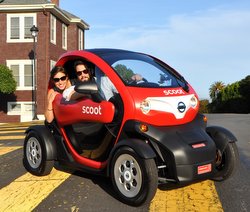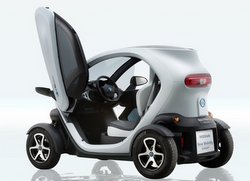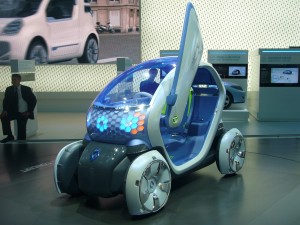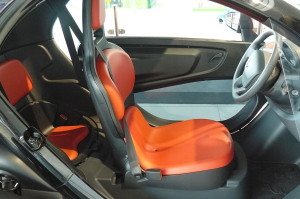Would You Commute in Nissan’s New Mobility Concept?
Smaller & Slower Is Better in This Design

Commuting has become a waking nightmare in many cities around the globe. Add the associated pollutants from gasoline and diesel-powered vehicles, and you have cause for some cities to consider either restricting or outright banning the polluters altogether, which Oslo, Norway (population 600,000) plans to do within the next four years.
Auto manufacturers are acutely aware of these facts and know that future transportation must include means other than the automobile as we know it. Yes, battery or hydrogen-powered electric cars are part, but not all of the solution.
The big challenge as cars are removed from city streets is improving personal mobility. How are urbanites going to get to work from home or take care of the various needs of daily life?
Nissan’s solution is the New Mobility Concept, an ultra-compact two-seat electric vehicle for every-day short distance urban driving. If you live in or are traveling to San Francisco, you don’t have to wait to see if this little four-wheeler is a possible answer for pollution-free urban transportation.
Nissan Teams With Scoot Networks
To evaluate how the Nissan New Mobility Concept can suit driving needs as transportation options evolve, 10 of the vehicles are now available as part of San Francisco based Scoot Networks’ fleet of light electric vehicles.
Scoot is a company that offers shared electric scooters that one can rent for riding in San Francisco and has 75 locations throughout the city. The Nissan New Mobility Concept vehicles are being called “Scoot Quad†by the network and join 400 custom scooters in service.
For those who might have trepidations about riding a two-wheeler at 30 miles an hour, the four-wheel Nissan New Mobility Concept offers stability and a 25 mph top speed that is the perfect

choice for scooting around the city. Plus, its 40-mile driving range is double that of the scooters and it does offer some protection against inclement weather.
Bay Area residents who want to try out a Scoot Quad can join Scoot and use their app — offered on both iOS and Android devices — to find the nearest vehicle. Rides start at $8 per half-hour or $80 per day/$40 night.
Some might dismiss the Scoot Quads as nothing more than glorified golf carts. While there is a small amount of validity in that description, they fall under the U.S. Department of Transportation classification of neighborhood electric vehicles (NEVs) because of added safety equipment. They join tens of thousands of NEVs already on California road as a result of the state’s ZEV (zero emission vehicle) regulation.
Depending on various state regulations, NEVs can only operate on roads with speed limits up to 40 mph and usually have a governed top speed of 25 mph. If nothing else, Scoot Quads may introduce people who would never have considered a NEVs to this class of electric vehicle.
Here’s a link to a video of the Nissan New Mobility Vehicle cruising around San Francisco.
It’s Really a Renault Twizy

In case you didn’t know, Japanese automaker Nissan and French automaker Renault formed a partnership alliance in 1999. Combined worldwide sales follow only Toyota, General Motors and Volkswagen. The top-selling electric vehicle of the Alliance is the Nissan Leaf EV, with more than 200,000 sold through the end of 2015 since its December 2010 introduction..
The Renault Twizy was first shown as a concept in the 2009 Frankfurt Motor Show. The following year Nissan introduced a Twizy near clone and named it the New Mobility Concept. Twizy went on sale in Europe in 2012, became the number one selling EV that year and has since sold nearly 20,000 units.
Nissan hasn’t provided any hard details about the New Mobility Concept, but a look at the Twizy provides a fairly clear picture.
Constructed around a lightweight steel frame wrapped with plastic panels, the little EV is just 90.6 inches long and 44.5 inches wide, which is smaller than the Smart ForTwo. Those micro-sized dimensions afford a 9.8-foot turning circle and combined with the scissor doors (which are optional), means you can park almost anywhere.
The open-air design eliminates a cramped feeling for driver. An ergonomically designed front seat is quite comfortable and slides forward to make access to the rear seat easier, but it is a squeeze to fit an adult in the back seat. There is some storage under the rear seat, just enough space for a large purse or laptop.
The dash layout is a simple affair dominated by a digital speedometer and battery charge indicator. There are two buttons: one for Drive, the other for Reverse. Push them together gives you neutral.
Powering the front wheels is a 20 horsepower (15 kilowatt) electric motor, with 52 pounds-feet of torque. That may not sound like much, but at 1,036 pounds the Nissan New Mobility Concept is a

light vehicle and reasonably quick around town.
A 6.1-kilowatt hour lithium-ion battery located underneath the front seat provides electricity for the motor. Recharging a depleted battery takes about four hours with a level-two 240-volt system.
Final Word
Nissan is not the only auto company that is extending its footprint beyond automobiles in an attempt to help find solutions to traffic congestion and pollution.
Ford’s experiment, called Handle on Mobility, features two electric bicycles (e-bikes), one for personal commuting, the other for commercial use. Then there’s Toyota‘s i-Road, an electric-powered three-wheeler that’s a cross between an automobile and motorcycle.
None of these three vehicles is the single answer to pollution-free urban transportation. But collectively they offer citizens choices that can help solve the problem. I hope all three are successful.
Related Article You Might Enjoy:
News: Ford’s Silicon Valley Lab Leads the Way on Smart Mobility
News: Autonomous Cars & Connected Mobility
News: Toyota Invests in Artificial Intelligence as a Road to Autonomous Cars
Photo credit (interior): By MOs810 – Own work, CC BY-SA 3.0, https:\commons.wikimedia.org\w\index.php?curid=20283857

0 thoughts on “News: Nissan Introduces New Mobility Technology”